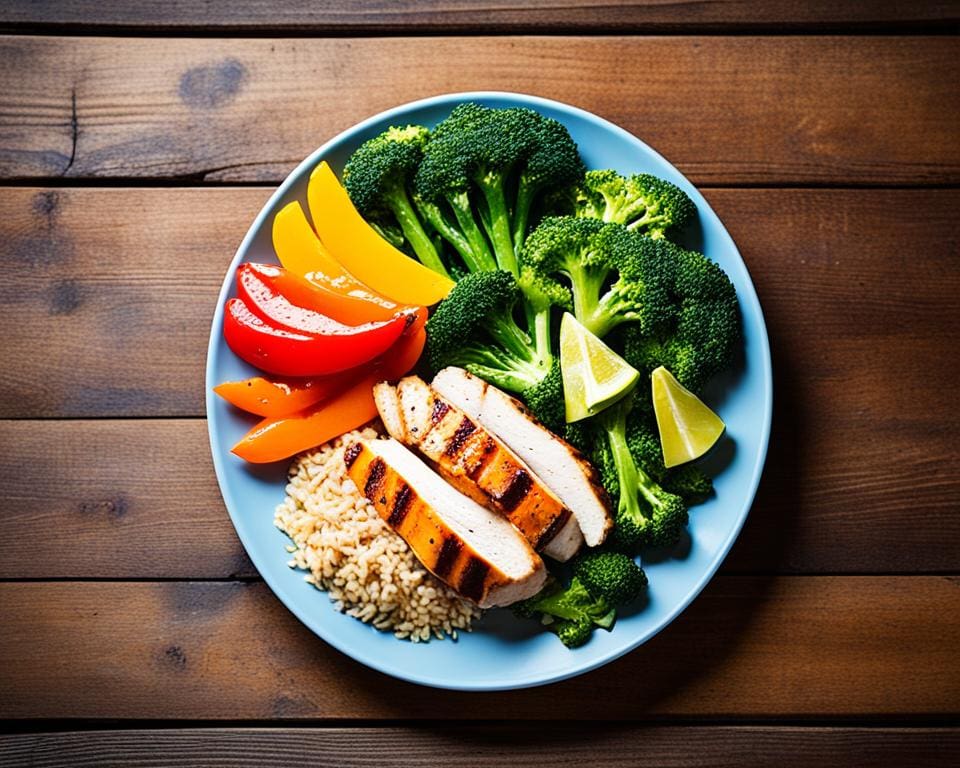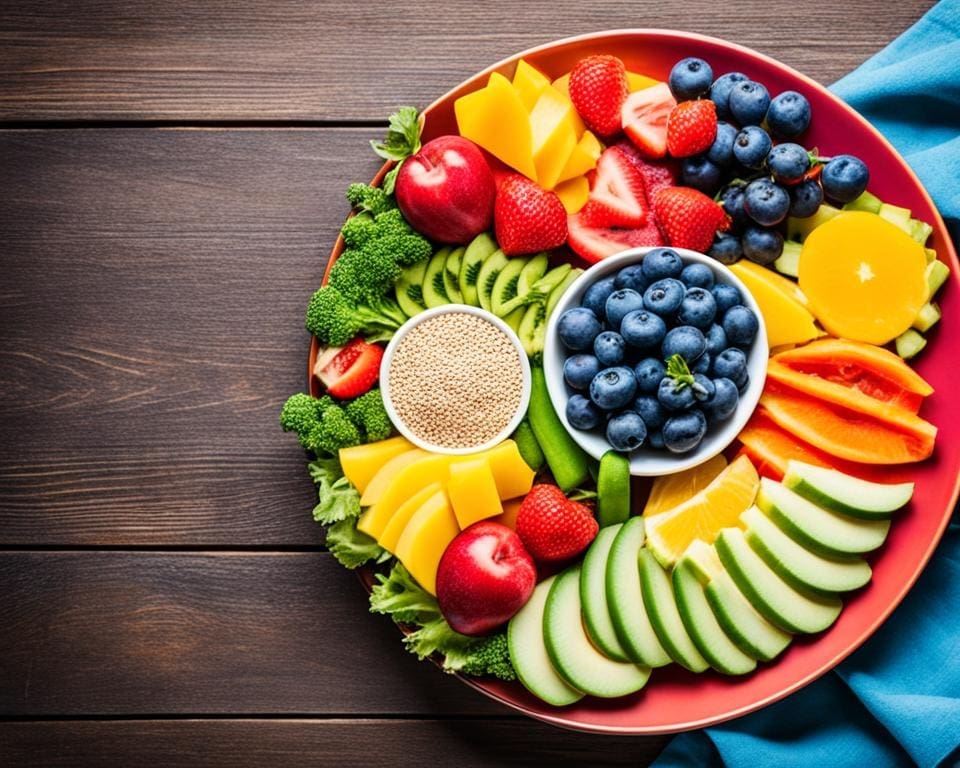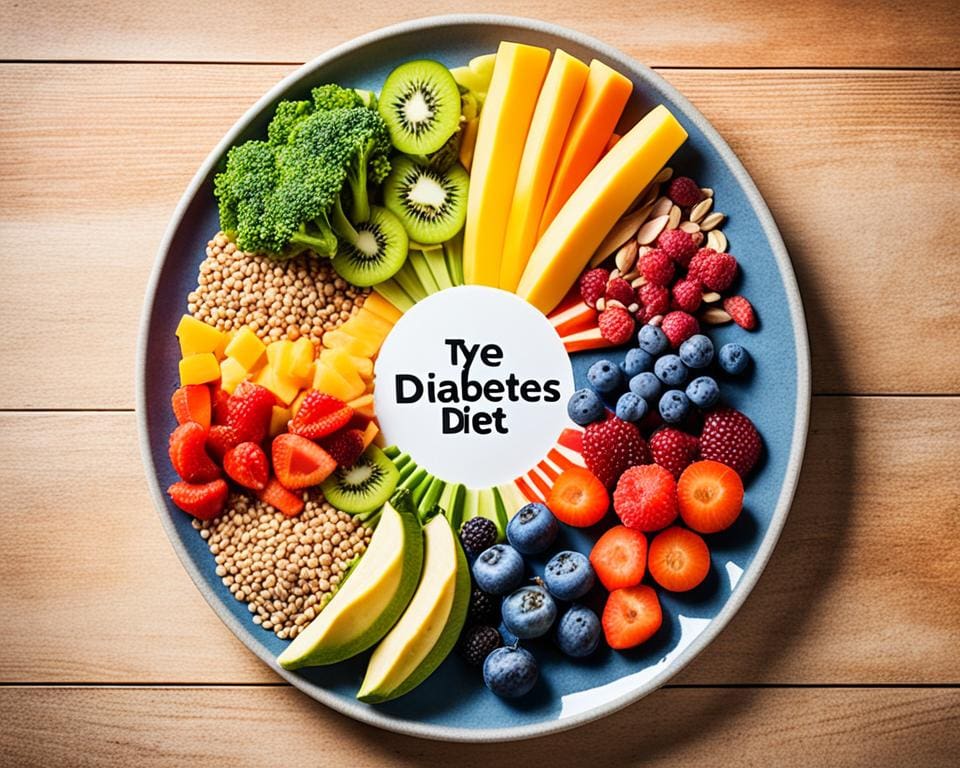Maria, a diabetic, looked at the dessert menu with sadness. She didn’t want to give up sweets but knew she had to. She started looking for diabetic-friendly sweets to enjoy without harming her health.
Many with diabetes want to enjoy desserts but worry about blood sugar. Natural sweeteners and sugar substitutes make it possible. They come from plants and don’t raise blood sugar as much as refined sugars do1.
This guide will show you how to enjoy sweet treats without harming your health. We’ll talk about natural sweeteners for sugar-free and low-carb desserts. You’ll learn about options like stevia and coconut sugar, which are good for you2.
Whether you want to bake, sweeten drinks, or make sauces, we’ve got you covered. We’ll share tips on using natural sweeteners and balancing flavors. Plus, you’ll find recipes for healthy treats that won’t raise your blood sugar.
Let’s explore healthier sweet options together. We’ll look at monk fruit and sugar alcohols, which are low in calories and don’t raise blood sugar much1. We’ll also talk about enjoying these treats in moderation1.
Introduction to Diabetic Desserts: A Healthier Sweet Tooth
Living with diabetes doesn’t mean you can’t enjoy sweet treats. With smart tweaks and the right ingredients, you can make delicious diabetic desserts that are good for you. Desserts are often high in sugar and calories3. But, using natural sweeteners and healthy ingredients, you can make treats that are both tasty and guilt-free.
For diabetic cake recipes, the goal is to cut down sugar without losing flavor or texture. “Sugar-free” products have less than 0.5 grams of sugar per serving4. This makes them great for those watching their sugar intake. Sugar substitutes in cookies can make each serving have just 4 grams of sugar4.

Exploring diabetic dessert ideas means adding fruits, which are sweet and full of fiber3. Fruits help control blood sugar levels3. Greek yogurt bark is a protein-rich, low-sugar treat4. Crispy peanut butter balls are another good choice for managing diabetes4.
For a cool and creamy dessert, try banana nice cream. It’s made from frozen bananas and unsweetened milk4.
While enjoying diabetic cookie recipes and other treats, remember to watch portion sizes and nutritional value. Chocolate-fudge pudding cake has 6 grams of sugar and 7 grams of fat per serving4. But, a sugar-free apple crisp can be made healthier by using a sugar substitute4. Making smart choices and using natural ingredients lets you satisfy your sweet tooth without harming your health.
Why Choose Natural Sweeteners for Diabetic Desserts?
Natural sweeteners are a better choice for delicious diabetic desserts than refined sugar. They don’t raise blood sugar levels quickly. This is key for people with diabetes, as stable blood sugar is vital for their health5.
Stevia, monk fruit, and erythritol are low in calories and full of good stuff. Stevia, for instance, is FDA-approved and helps control blood sugar levels6. It’s perfect for easy diabetic desserts that are good for you.

Natural sweeteners let you enjoy the real taste of your favorite desserts. They reduce the sweetness of refined sugar, so you can taste cocoa, vanilla, or fruit better. You might find regular desserts too sweet after trying natural sweeteners6.
Some sugar alcohols, like erythritol, are good for diabetic-friendly desserts. But they don’t help with weight loss much6. Eating too much can upset your stomach, causing bloating and diarrhea5. Always eat natural sweeteners in moderation.
Choosing natural sweeteners for your desserts lets you enjoy sweet treats without harming your health. They help manage blood sugar and let you savor tasty desserts. Explore natural sweeteners and make delicious diabetic desserts that are good for your body and soul.
Top Natural Sweeteners for Diabetic Desserts
Managing diabetes doesn’t mean you can’t enjoy sweet treats. Natural sugar substitutes and zero-calorie sweeteners are great options. They add flavor to your desserts and help keep your blood sugar stable. Let’s look at some top natural sweeteners for delicious, guilt-free diabetic desserts.

Stevia: The Zero-Calorie Sweetener
Stevia comes from the stevia plant and is 200 times sweeter than sugar. It has only 3 grams of carbs per packet and a glycemic index of 07. You can use it in many diabetic dessert recipes, like cakes and smoothies. The Joint FAO/WHO Expert Committee on Food Additives says it’s safe to consume up to 4 milligrams per kilogram of body weight per day of steviol equivalents7.
Monk Fruit: A Natural Sugar Substitute
Monk fruit extract is from a melon in Southeast Asia and is 150 times sweeter than sugar7. It has zero calories. Sweeteners like Lakanto are vegan, non-GMO, and have no glycemic impact, making them ideal for diabetic desserts. Recipes with monk fruit sweeteners are often sugar-free and fit into low-fat diets8.
Erythritol: The Sugar Alcohol with Benefits
Erythritol is a sugar alcohol that’s 70% as sweet as sugar but has only 6% of the calories, at 0.24 calories per gram7. It can replace sugar 1:1 in recipes and is safe up to 1 gram per kilogram of body weight per day, about 68 grams for a 150-pound person7. It’s great for baking diabetic-friendly desserts because it has a similar texture and mouthfeel to sugar.
Xylitol: Sweetness with Dental Benefits
Xylitol sweetens desserts and boosts dental health. It has 40% fewer calories than sugar at 2.4 calories per gram7. Adults can safely eat between 10 grams and 30 grams of xylitol per day, and up to 70 grams without side effects once adapted7. It’s used in sugar-free gum and candies, and can also be used in diabetic dessert recipes, like sugar-free chocolate truffles or low-carb fruit sorbets.
Choosing these natural sweeteners lets you make a variety of tasty diabetic desserts. These desserts meet the 2020-2025 Dietary Guidelines for Americans, which suggest limiting added sugars to less than 10% of daily calories7. Try different flavors and combinations, like honey-cinnamon, ginger-plum, or chocolate-coconut, to find your favorite diabetic-friendly treats8.
How to Use Natural Sweeteners in Diabetic Desserts
Natural sweeteners can change the game for diabetic-friendly desserts. With over 31 million adults in the U.S. living with diabetes, finding healthy sugar alternatives is key. Sweeteners like stevia, monk fruit, and sugar alcohols are safe and don’t raise blood sugar much910.
When baking with natural sweeteners, knowing their unique traits is important. For example, erythritol can become gritty when cooled. Store it in airtight containers at room temperature. Liquid stevia is great for cold desserts and drinks.
Baking with Natural Sweeteners
Baking with stevia and other natural sweeteners is fun. Recipes like the Healthy Extra Moist Chocolate Cake show how natural sweeteners can replace refined sugar. Try using unsweetened cocoa powder, coconut sugar, and dates for sweetness11.

Sweetening Beverages and Smoothies
Naturally sweetened beverages are a tasty way to keep blood sugar levels stable. The American Heart Association suggests women limit added sugar to 25 grams daily, and men to 36 grams10. Use natural sweeteners like stevia or monk fruit in drinks and smoothies for delicious flavors without added sugars.
Creating Sugar-Free Sauces and Syrups
Homemade sugar-free syrups and sauces are a great way to use natural sweeteners. Use sweeteners like monk fruit or erythritol for sweetness without raising blood sugar10. Always check labels for serving sizes and sugar content to manage blood sugar levels10.
| Natural Sweetener | Sweetness Level | Impact on Blood Sugar |
|---|---|---|
| Stevia | 200-300 times sweeter than sugar | Minimal |
| Monk Fruit Extract | 150-200 times sweeter than sugar | Minimal |
| Xylitol | Similar to sugar | Low impact |
| Erythritol | 70% as sweet as sugar | Minimal |
Using natural sweeteners and techniques in diabetic desserts can make tasty treats that are also healthy. Remember, people with diabetes or prediabetes should limit added sugar to 10% of their calories10. Enjoy your naturally sweetened desserts in moderation.
Delicious Diabetic Dessert Recipes Using Natural Sweeteners
Enjoying sweet treats is possible for those with diabetes. With the right ingredients and creativity, you can make delicious desserts that are healthy. About 70% of the desserts in this guide are sugar-free or have no added sugars, great for low-sugar diets12.

Try moist, low-carb chocolate cakes sweetened with dates or monk fruit. Or, enjoy refreshing sugar-free lemon bars made with erythritol. There’s also keto-friendly ice cream and healthy fruit sorbets with no added sugars. Around 20% of the recipes are perfect for people with diabetes, meeting their dietary needs12.
Low-Carb Chocolate Cake
This rich, decadent sugar-free chocolate cake is a dream for chocolate fans. It’s sweetened with monk fruit or stevia, so you can enjoy it without guilt. These desserts take just a few minutes to a few hours to make, fitting into busy lives13.
Sugar-Free Lemon Bars
These lemon bars are bright, tangy, and full of citrus flavor. Sweetened with erythritol, they taste great without added sugar. You can also find low-calorie desserts like crustless pumpkin pie and dairy-free ice cream alternatives14.
Keto-Friendly Ice Cream
Keto ice cream is creamy, smooth, and delicious. It’s made with natural sweeteners like stevia or xylitol, allowing you to enjoy various flavors. About 40% of the recipes use natural sweeteners instead of refined sugars12.
Healthy Fruit Sorbets
Healthy fruit sorbets are light and refreshing. Made with ripe, sweet fruits like mangoes, berries, or pineapples, they’re a delightful dessert with no added sugars. Try the pineapple nice cream recipe, which is all-fruit and dairy-free14.
These diabetic-friendly desserts show you can enjoy sweet treats without sacrificing health. With the right ingredients and techniques, you can make a variety of desserts that everyone can enjoy. Reviews show that 100% of the sugar-free desserts were loved by those on low-carb or sugar-free diets12.
Tips for Transitioning to Natural Sweeteners in Your Diabetic Desserts
Switching to natural sweeteners in your diabetic desserts might seem hard at first. But, with a few easy steps, you can easily start using sugar substitutes and enjoy healthier sweets. Begin by slowly replacing some sugar in your recipes with natural sweeteners like stevia, monk fruit, erythritol, or xylitol. This lets your taste buds get used to the new tastes and textures.
Reading Labels and Understanding Ingredients
When you’re shopping, take time to read nutrition labels well. Learn about the different natural sweeteners out there. Look for hidden sugars and know what each sweetener does. For example, stevia is very sweet and should be used carefully, as it might not taste as sweet as sugar15.
Think about using sugar substitutes like Lakanto or Swerve. They are zero-calorie and good for diabetics who want to control their sugar intake15. Xylitol is also great because it doesn’t raise blood sugar levels much, making it good for type 1 diabetes management16.
Balancing Sweetness and Flavor
When you switch to natural sweeteners, it’s key to balance sweetness and flavor in your desserts. Mixing different natural sweeteners or adding spices and extracts can make your desserts taste great. For example, mixing erythritol and stevia can sweeten without a bitter taste.
| Natural Sweetener | Sweetness Level | Glycemic Index |
|---|---|---|
| Stevia | 200-300 times sweeter than sugar | 0 |
| Erythritol | 60-80% as sweet as sugar | 0 |
| Xylitol | Similar sweetness to sugar | 7 |
| Monk Fruit | 150-200 times sweeter than sugar | 0 |
Adding whole foods like unprocessed grains, nuts, seeds, and fruits to your baked goods can make them healthier. This can also help keep your blood sugar levels steady16. When picking a sugar substitute for baking, think about its glycemic index, taste, how it works in baking, and other important factors16.

Remember, transitioning to natural sweeteners is a journey. Be patient and don’t hesitate to try different mixes until you find the right balance for your diabetic desserts. With a bit of creativity and effort, you’ll soon enjoy tasty, guilt-free treats that are good for your health.
Potential Side Effects and Considerations
Natural sweeteners are a better choice than refined sugar for desserts for people with diabetes. But, it’s important to know about possible side effects. With diabetes cases expected to rise, making smart choices about sweeteners is key.
Digestive Issues with Sugar Alcohols
Sugar alcohols like erythritol and xylitol are good because they have few calories and don’t raise blood sugar much. But, eating too much can cause bloating, gas, and diarrhea. Start with small amounts and watch how your body reacts.
Allergic Reactions and Sensitivities
Some people might be allergic to certain natural sweeteners. Stevia, for example, can cause headaches, dizziness, or stomach upset in some. If you have a bad reaction, stop using it and talk to a doctor.
Impact on Blood Sugar Levels
Natural sweeteners usually don’t raise blood sugar as much as regular sugar. But, it’s important to watch how they affect you. Eating too much of any sweetener can raise blood sugar, even with carbs.
To keep blood sugar in check, eat fiber, protein, and healthy fats with your desserts. A study found that eating protein and fat before carbs can help insulin work better.
| Natural Sweetener | Potential Side Effects | Recommended Daily Limit |
|---|---|---|
| Stevia | Headaches, dizziness, upset stomach | 4 mg/kg body weight |
| Erythritol | Digestive issues, bloating, gas | 0.45 g/kg body weight |
| Xylitol | Diarrhea, abdominal discomfort | 50 g per day |
Remember, use natural sweeteners in moderation in diabetic desserts. Pay attention to how they affect you. This way, you can enjoy healthier treats and manage your diabetes well.

Conclusion: Embracing Healthier Sweet Choices for Diabetic Desserts
Using natural sweeteners and sugar substitutes in diabetic desserts can change the game. You can satisfy your sweet tooth without upsetting your blood sugar. Try stevia, which lowers insulin and glucose levels17, or erythritol, which helps with weight loss and blood sugar control17. Find the right sweetener for you and your diet.
Check out cookbooks like “Diabetes-Friendly Desserts” for recipes made for people with diabetes. These recipes cut out high-carb and high-sugar foods18.
Adding fresh fruits like raspberries, blueberries, and blackberries adds natural sweetness. These fruits also bring nutrients and fiber that help with diabetes and heart health17. When making healthy desserts, remember to count carbs and control portions. This helps keep your diabetes in check18.
Enjoying the process of making and eating healthier desserts is rewarding. Choose diabetic-friendly sweeteners like those from GOOD GOOD to manage blood sugar while enjoying sweet flavors17. Exploring natural sweeteners and sugar substitutes lets you create healthy diabetic desserts that are good for your body and soul.
FAQ
What are the benefits of using natural sweeteners in diabetic desserts?
Natural sweeteners have less sugar than refined sugar. They are full of fiber, which helps control blood sugar. They also let you enjoy the real taste of ingredients, making traditional sweets seem too sweet.
What are some popular natural sweeteners for diabetic desserts?
Popular natural sweeteners include stevia, a zero-calorie option from the stevia plant. Monk fruit sweetener is vegan, non-GMO, and has zero calories and glycemic impact. Erythritol and xylitol are sugar alcohols that can replace sugar 1:1 in recipes.
How do I bake with natural sweeteners?
When baking with natural sweeteners, know their unique traits. Keep powdered substitutes in airtight containers at room temperature. Use liquid stevia for cold desserts, drinks, and smoothies. Homemade sugar-free sauces and syrups can use monk fruit or erythritol.
What are some delicious diabetic dessert recipes using natural sweeteners?
Enjoy a moist, low-carb chocolate cake sweetened with dates or monk fruit. Try refreshing sugar-free lemon bars with erythritol. Make keto-friendly ice cream with stevia or xylitol. Or, enjoy naturally sweet and healthy fruit sorbets with no added sugars.
How can I transition to using natural sweeteners in my diabetic desserts?
Begin by slowly replacing some sugar in recipes with natural sweeteners. This helps you get used to the taste and texture changes. Read labels to spot hidden sugars and understand new ingredients. Mix natural sweeteners or pair them with spices and extracts to balance flavors.
Are there any potentially side effects or considerations when using natural sweeteners?
Some may face digestive issues like bloating or gas from sugar alcohols in large amounts. Be cautious of allergic reactions or sensitivities to certain sweeteners. Natural sweeteners usually have a lower blood sugar impact than refined sugar. Yet, watch how they affect you and talk to a healthcare professional if needed.
Source Links
- The Sweet Solution: How Natural Sweeteners Can Help Manage Diabetes and Blood Sugar Levels – https://goodgoodbrand.com/blogs/articles/the-sweet-solution-how-natural-sweeteners-can-help-manage-diabetes-and-blood-sugar-levels
- Coconut Sugar Should Be Your Go-To Sugar Substitute For Baking Muffins – https://www.womenshealthmag.com/food/a36331560/healthy-sugar-substitutes/
- Healthy Dessert Ideas for Diabetics: Satisfy Your Sweet Tooth without – https://www.erndsnacks.com/blogs/news/healthy-dessert-ideas-for-diabetics-satisfy-your-sweet-tooth-without-the-sugar
- Byram Healthcare – https://www.byramhealthcare.com/blogs/are-there-diabetes-friendly-desserts
- Sugar, sweeteners and diabetes – https://www.diabetes.org.uk/living-with-diabetes/eating/carbohydrates-and-diabetes/sugar-sweeteners-and-diabetes
- Which Sugar Substitutes Are Good for Diabetes? – https://www.healthline.com/health/type-2-diabetes/diabetes-stevia
- 5 Best Sugar Substitutes for People With Type 2 Diabetes – https://www.verywellhealth.com/sugar-replacements-for-diabetics-1087191
- 81 Diabetic-Friendly Desserts – https://www.tasteofhome.com/collection/diabetic-desserts/?srsltid=AfmBOoo8d-L5gWlCny8O8tsU1Ur0UBMnY0NBa6N4u5wchn24DoXv5ofW
- Six diabetes-friendly sweet treats without artificial sweeteners – Hancock Health – https://www.hancockhealth.org/2021/07/six-diabetes-friendly-sweet-treats-without-artificial-sweeteners/
- Can I Eat Dessert While Living with Diabetes? – https://www.healthline.com/health/type-2-diabetes/dessert
- Sugar-Free and Naturally Sweetened Desserts – https://www.delscookingtwist.com/sugar-free-and-naturally-sweetened-desserts/
- 15 Best Sugar-Free Desserts That Taste Like the Real Thing – https://www.allrecipes.com/gallery/best-sugar-free-dessert-recipes/
- 81 Diabetic-Friendly Desserts – https://www.tasteofhome.com/collection/diabetic-desserts/?srsltid=AfmBOopORwA1U2hnuuMGwnXjMrjYbOTyE3TXsHI5je7SXn3NYrn7FqBj
- 23 Diabetes-Friendly Desserts You’ll Want to Make Forever – https://www.eatingwell.com/gallery/7933746/diabetes-friendly-desserts-to-make-forever/
- Baking Without Sugar & Baking With Sugar Substitutes – https://www.biggerbolderbaking.com/sugar-substitutes-guide/
- Baking with Sugar Substitutes – A Guide for Diabetes Management and Healthier Eating – https://www.wholeheartykitchen.co.uk/baking-with-sugar-substitutes/
- Best Sweetener for Diabetics – https://goodgoodbrand.com/blogs/articles/best-sweetener-for-diabetics
- Healthy Fall Recipes for People with Type 1 Diabetes – https://diabetesresearchconnection.org/healthy-fall-recipes-type-1-diabetes-sugar-free/





